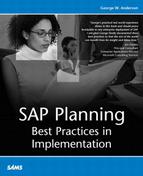Purpose of This Chapter
This chapter takes a closer look at total cost of ownership analysis, or TCO analysis. The idea at this stage in your SAP project is not to justify the project so much as to determine where and when the costs are incurred within the context of the SAP Solution Stack and ongoing operations. You also need to be able to compare various solution stack options and alternatives from a holistic cost perspective. By calculating rough costs before embarking upon major technology purchases, or before fleshing out the SAP Technical Support Organization with incremental and expensive human resources, the composition of the solution stack you eventually go “live” with will not only meet your business needs, but also reflect your budget needs.
A few years ago, one of my SAP customers put the whole TCO analysis process in perspective—TCO analysis limited their (solution stack) choices to better reflect their real-world budget constraints. Of course, in the end, if the choices that have been made fail to address the real needs of the business for which SAP has been employed—business process, availability, performance, and so on—the project will fail. So TCO analysis is also about balancing these requirements against their costs as well. The goal is simple—ultimately, a trade-off or compromise must be reached where the end-user organizations and financial bean counters see eye to eye.
How you achieve that goal is addressed throughout this chapter. The first half of the chapter looks at the decisions made in regard to specific solution stack components: hardware platforms, the OS and database selections, high-availability and performance options, and so on. These are one-time implementation costs. Afterwards, I take a closer look at recurring costs, such as annual maintenance fees, upgrade/update fees, the cost of downtime to perform such updates, and more. I also look closely at tools and approaches offered by software vendors, hardware partners, and SAP AG alike, designed to reduce TCO and maximize ROI.
By the end of this chapter, through using the simple tools and approaches I have developed over the years, many of the solution stack decisions that you may be currently struggling with should be clearer. The only questions remaining should be those involving the complex details of high availability and disaster recovery, which are addressed in more detail in Chapter 6. By the time you begin Chapter 7, you will be in a position to fully engage your SAP Solution Stack vendors and partners and either publish an RFI/RFP or begin answering solution stack vendors’ questions related to each mySAP.com component you intend to implement as part of your mySAP solution strategy. That is, based on all of the business, technology, people, process, and budget requirements and constraints identified through the first six chapters of this book, you will be well prepared to move forward into the realm of solution sizing.
